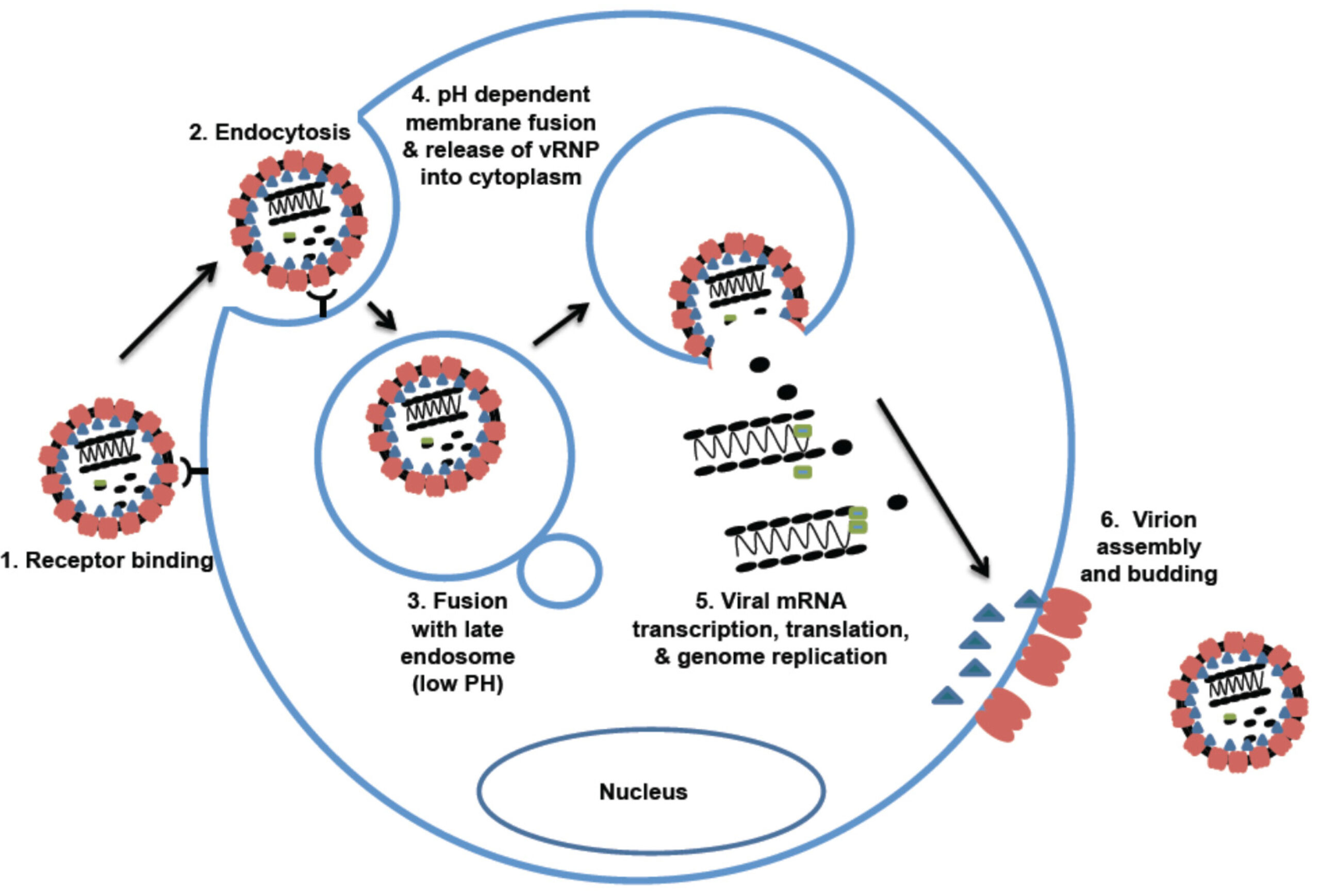Playlist
Show Playlist
Hide Playlist
Lymphocytic Choriomeningitis Virus (LCMV) and Lassa Fever Virus – Arenaviruses
-
02-49 Arenaviruses.pdf
-
Download Lecture Overview
00:01 The arenaviridae, viruses. 00:04 The arenaviruses or the arenaviridae family are a mid-sized virus which are enveloped and they have a helical capsid, which you can see on the image in front of you on the right. 00:17 They contain a circular, single-stranded, negative sense, segmented RNA genome, which means they must also carry an RNA-dependent RNA polymerase, the RDRP. 00:28 They have, due to cellular ribosomes, a sandy appearance, which you could also see on the image in front of you. 00:34 To me, it's a very beautiful image, especially when it's colorized like this picture. 00:39 There are 2 medically important species in the arenavirus family. 00:44 The lymphocytic choriomeningitis virus, or LCMV, for short, and the Lassa fever virus, which is important if you follow many outbreaks in Africa. 00:56 Let's look at the diseases, sorry, first caused by lymphocytic choriomeningitis virus, LCMV. 01:04 The incubation period is 1 to 2 weeks or 6-13 days, as you see on the slide in front of you. 01:10 And LCMV infused virus -- When it first causes disease starts as a flu-like illness, so fevers, malaise, decreased appetite, the whole 9 yards. 01:24 However, the disease then progresses in a quarter of cases to a full-fledged meningitis and encephalitis So, confusion, headache, photophobia, neck pain, sometimes stupor or even coma. 01:39 The complications in those patients then, might even be permanent neurologic damage due to encephalitis, so cognitive delay, seizure disorder, etc. 01:51 The Lassa hemorrhagic fever virus is completely different, not just in the incubation period, which is up to 21 days, but in its whole behavior. 02:01 And in fact, if you picture what Ebola virus and Marburg virus are like, you'll get a better picture of the Lassa hemorrhagic fever virus. 02:10 So, as mentioned, incubation period, 1-3 weeks, up to 21 days. 02:15 Thankfully, 80% of cases are asymptomatic, but the remaining 20% will have fevers followed by evidence of coagulopathy, of hemorrhage. 02:24 So, disseminated intravascular coagulopathy, petechiae in the skin, liver failure, spleen necrosis, visceral hemorrhage, so basically, bleeding out from everywhere. 02:36 So, from the eyes, from the nose, the mouth, hematemesis, hematochezia -- bloody stools -- you name it. 02:43 So, complications, then, are myositis, and in those few patients who are given aspirin, which would be unusual if they're already bleeding out, but if they did receive aspirin, they might develop further fulminant liver failure called Reye's syndrome. 03:00 So, the transmission of both viruses comes from this cute little rodent in front of you, typically, mice or sometimes, small rats. 03:09 And the virus is excreted in the rat excreta, so feces, urine. 03:16 It is then, when it's aerosolized or through fomite transmission, ingested or even inhaled by the human being. 03:25 In the States and in other parts of the world where there is a temperature change, a classic time to be exposed to LCMV is during the winter. 03:37 Doesn't make sense, right? Viruses always seem to be like, you know, respiratory in the wintertime, but in this case, the rodents come in from the cold, and they may be nesting inside the house. 03:49 And so, their urine and stool is far more likely to be inhaled, aspirated, or ingested during the winter months when they're inside. 03:58 Treatment for both viruses. 04:00 Well, Ribavirin is an antiviral. 04:03 It's a guanosine analogue, but it is of limited efficacy and is far more likely that the patients just require supportive measures to get through the infection which they're dealing with. 04:14 In the case of Lassa fever virus, that is many times going to be extensive blood product support, and even sometimes blood pressure support because Lassa fever virus is quite significant. 04:26 So, 2 different viruses in the same family, 2 completely different clinical effects. 04:33 And largely, it is based on what tissue tropism, what cell tissue is their target, in terms of how these 2 viruses proceed. 04:42 So, I guess the message of this story is to avoid rodent urine and feces.
About the Lecture
The lecture Lymphocytic Choriomeningitis Virus (LCMV) and Lassa Fever Virus – Arenaviruses by Sean Elliott, MD is from the course Viruses.
Included Quiz Questions
The typical incubation period of infection by the Lassa fever virus is which of the following?
- 6–21 days
- 1–4 days
- 21–28 days
- 30–38 days
- 40–45 days
Which of the following refers to the approximate percentage of cases of lymphocytic choriomeningitis that will have central nervous system involvement?
- 25%
- 10%
- 50%
- 75%
- 90%
Administration of aspirin to an individual infected by the Lassa virus may cause liver involvement and further worsening of the patient's condition leading to a syndrome known as which of the following?
- Reye syndrome
- Rett syndrome
- Riley-Day Syndrome
- Rombo syndrome
- Reynolds syndrome
Customer reviews
5,0 of 5 stars
| 5 Stars |
|
5 |
| 4 Stars |
|
0 |
| 3 Stars |
|
0 |
| 2 Stars |
|
0 |
| 1 Star |
|
0 |





